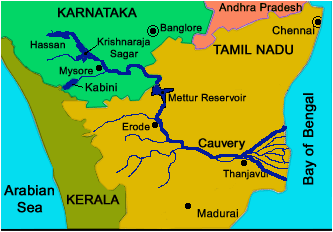Governance
Cauvery River Water Dispute
- 29 Sep 2021
- 5 min read
Why in News
Recently, the Cauvery Water Management Authority (CWMA) directed Karnataka to immediately release the balance quantum of water to Tamil Nadu.
- However, CWMA dropped discussion on the Mekedatu reservoir project following “strong protest” from Tamil Nadu, Kerala and Puducherry.
Key Points
- Cauvery Water Dispute:
- About:
- It involves 3 states and one Union Territory (Tamil Nadu, Kerala, Karnataka and Puducherry).
- The genesis of the dispute is 150 years old and dates back to the two agreements of arbitration in 1892 and 1924 between the then Madras presidency and Mysore.
- It entailed the principle that the upper riparian state must obtain consent of lower riparian state for any construction activity viz. reservoir on the river Cauvery.
- Recent Developments:
- From 1974, Karnataka started diverting water into its four newly made reservoirs, without the consent of Tamil Nadu resulting in a dispute.
- To resolve the matter, the CWDT (Cauvery Water Disputes Tribunal) was established in 1990 which took 17 years to arrive at the final order (2007) on how Cauvery water should be shared between the 4 riparian states in normal rainfall conditions.
- CWDT was constituted by the Central Government, in exercise of the powers conferred by section 4 of the Inter-State River Water Disputes Act, 1956.
- In distress years, a pro-rata basis shall be used, it instructed. The government again took 6 year and notified the order in 2013.
- This was challenged in SC (Supreme Court) which directed Karnataka to release 12000 cusecs of water to Tamil Nadu prompting protests in the State.
- The final verdict of the SC came in 2018 where it declared the Cauvery a national asset and largely upheld the water-sharing arrangements finalised by the CWDT and also reduced the allocation of water from Karnataka to Tamil Nadu.
- As per the SC, Karnataka would get 284.75 thousand million cubic feet (tmcft), Tamil Nadu 404.25 tmcft, Kerala 30 tmcft and Puducherry 7 tmcft.
- It also directed the Centre to notify the Cauvery Management Scheme. The central government notified the ‘Cauvery Water Management Scheme’ in June 2018, constituting the ‘Cauvery Water Management Authority’ and the ‘Cauvery Water Regulation Committee’ to give effect to the decision.
- About:
- Mekedatu Reservoir Project:
- It aims to store and supply water for drinking purposes for the Bengaluru city. Around 400 megawatts (MW) of power is also proposed to be generated through the project.
- In 2018, Tamil Nadu approached the SC against the project even if Karnataka had held that it would not affect the flow of water to Tamil Nadu.
- TN is opposed to any project being proposed in the upper riparian unless it was approved by the SC.
- It is known as ‘Ponni’ in Tamil, also known as Ganga of the south, and it is the fourth largest river of southern India.
- It is a sacred river of southern India. It rises on Brahmagiri Hill of the Western Ghats in southwestern Karnataka state, flows in a southeasterly direction through the states of Karnataka and Tamil Nadu, and descends the Eastern Ghats in a series of great falls and drains into Bay of Bengal through Pondicherry.
- Some of its tributaries are Arkavathi, Hemavathi, Lakshmana Theertha, Shimsa, Kabini and Harangi.
Way Forward
- The states need to shed the regional approach as the solution lies in cooperation and coordination, not in conflict. The planning must be done at the basin level to make the solution sustainable and ecologically viable.
- In the long term, there is a need to recharge the river through afforestation, river linking, etc and increased focus is needed on increasing water use efficiency viz. micro irrigation, awareness in people to prudently use water and water smart strategies.







